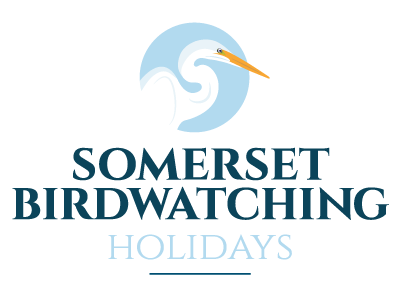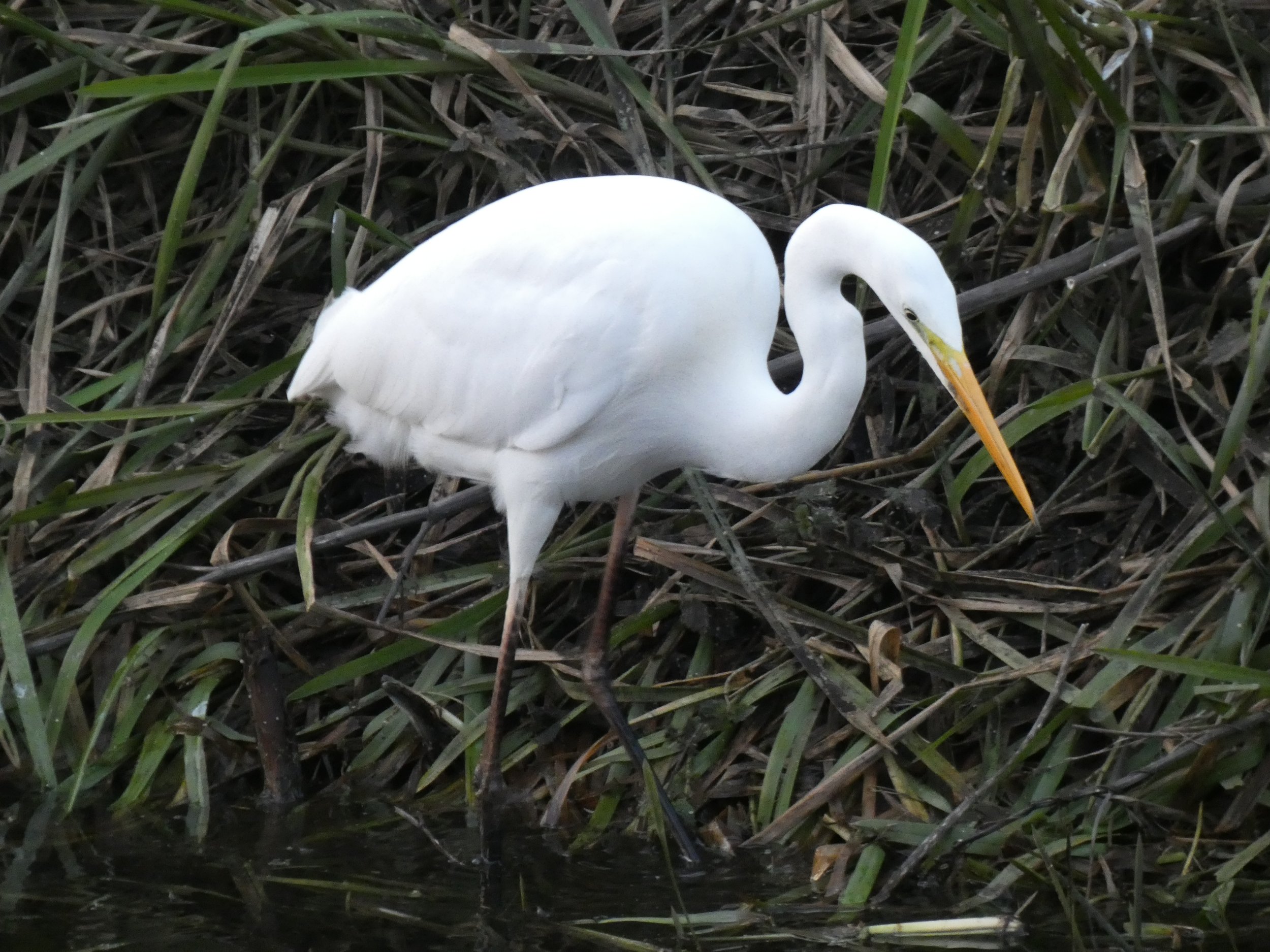Brass Monkeys & Starlings
Trip Report
17-19th January 2024
Tour Leaders
Graeme Mitchell and Brett Westwood
Wednesday 17th January 2024
We were sure that a troop of Brass Monkeys skipped out in front of the van when we arrived at our first birdwatching spot on Tealham Moor – perhaps of course it could have been an hallucination due to the sub-zero temperatures that hit us as we left the warmth of the van!
Lapwings, fieldfares, and cattle egrets gathered across the wet fields picking off the worms that had surfaced after the recent floods that had covered this low-lying area of the Somerset Levels since the heavy rains at New Year. Large great white egrets dotted the fields with the occasional grey heron trying not to look too put-off by their more graceful and marginally larger usurper cousins.
A dark buzzard hunched in a distant tree and a couple of stonechats flitted around the reed-tops at the edge of the field ditches, or rhynes as they are known locally.
Further along the road, in an area known as Tadham Moor, more and more fieldfares and redwings flocked across towards the small oakwood which was the site of the first breeding cattle egrets in the country in 2008.
We diverted off the Wedmore to Glastonbury road towards the Somerset Wildlife Trust’s nature reserve Westhay Moor, and in an adjacent field we checked a large number of mute swans for a lone whooper swan and three glossy ibis that had been reported – there certainly were no glossies to be seen, and if the whooper was still there it was doing a good job of hiding its yellow and black bill. However, we were rewarded by a good view of a normally very shy Cetti’s warbler, and which was calling in roadside reeds close to the rear of the van. In a nearby pond that wasn’t completely frozen, among some of the tufted ducks we managed to spot a female goldeneye: admittedly not quite as smart as a male, but a nonetheless a good bird for Somerset.
At the carpark at Ham Wall we were faced with a conundrum, as the RSPB staff explained that on the previous evening the starlings had split in two distinct groups when they came in to roost, when half had continued over into the adjacent reserve at Shapwick Heath with the others returning to roost close to the main viewing platform at Ham Wall.
We plumped to give Ham Wall a go, and decided if the majority of birds continued into Shapwick we could always go there on the next evening.
It was to be a good call.
From the viewing platform we enjoyed a good mix of wildfowl which were on what water wasn’t frozen including pochard, shoveler, teal, gadwall and wigeon – with our first sighting of little egrets and several marsh harriers patrolling the reed-tops spooking the odd snipe to take to the air.
Ham Wall sunset
By 4.30 the sky was on fire with a low setting sun as the first streams of starlings flew in over our heads. More and more flew over but did not seem to be stopping, continuing on towards Shapwick – but then a few birds chose to hit the brakes and bank round back towards where we were standing. The reeds filled almost to overflowing with chattering birds. Skies darkened with continuing streams of starlings pouring in from all directions. Every now and then, there would be a whoosh of unsettled birds that would take to the air and move like a tidal wave across the reedbeds. At one point the willow trees adjacent to the reeds were completely black with perching birds giving the appearance of a giant’s ants nest swarming with febrile activity.
As the last of the light faded from the sky, the show was over for another evening, and we returned to Walls Farm for a lovely supper prepared by Kay served with good conversation and lashings of Brett’s entertaining anecdotes on all things natural history.
Thursday 18th January 2024
Another ‘Baltic’ morning dawned, but a bright sun gave us some cheer as we headed off through Bridgwater to the Steart Marshes, managed by the Wildfowl and Wetlands Trust.
Graeme had spent the latter part of the journey extolling the delights of the facilities at this new nature reserve so was somewhat crestfallen to discover that the loos were out of action due to the extreme cold!
Well wrapped up, our plucky group crackled along the frozen track to the Quantock hide with the only bird action being a few close fieldfares and a couple of stonechats in the hedges. As expected virtually all the lagoons were frozen solid with just a few brave wigeon, shelduck and teal managing to eke out some grazing at the edge of the ice. No other birds were daft enough to brave the conditions other than a single (rather beautiful) avocet.
We were a little more successful scanning the ‘Gobi Desert’ as though usually birdless, - hence the name - a few little egrets and skylarks were seen along with a flock of linnets and at least two hunting marsh harriers.
Back in the van we continued another half mile to a parking area next to a samphire- covered saltmarsh known as Wall Common. It was just a short walk to the pebbly beach overlooking an incoming tide the same colour and consistency of hot chocolate.
Ah ha….this is where all the birds had been hiding!
In front of us and stretched along the coast were thousands of ducks and wading birds. Scattered wigeon and many shelduck shone against a coffee-coloured sea with the sea and three pintail flew over. Jittery flocks of dunlin shimmered like localised blizzards, brilliant white against the brown waters, resting nervously on the tideline with a few larger and stockier grey plover and a dozen or so turnstones. Good numbers of curlew were a pleasure to see too. Buoyed by such a glut of birdlife we celebrated with a warming coffee and posh biscuits at the back of the van.
Back on the levels we had time to pop into RSPB Greylake which was also frozen over, greatly reducing the number of birds on display. That said, we all enjoyed a close-up view of a handsome snipe trying to convince us it was a tuft of sedge,very close to the hide and a water rail skuttled across the ice right in front of our party. Another usually elusive bird the Cetti’s warbler gave us good views, looking somewhat like a pumped-up wren.
As always, we were allocated the best table at the King Alfred Inn (next to the fire) and we all enjoyed a wholesome lunch of burnt cakes.
In the afternoon we played a game which was to be almost as compelling as the current TV craze of ‘Traitors’ which we called ‘Hunt the Cranes’ this concluding successfully from the viewpoint in RSPB Swell Wood overlooking a stunning vista of the Somerset Levels. Quickly Brett got on to two cranes and then Graeme spotted a further four birds pecking around the drier edges of the flooded fields stretching out below us.
The Heronry’s open fronted hide was quiet with only a mousy wren and a couple of grey squirrels, however the feeders at the carpark brought great and coal tits along with the much rarer (and misnamed) marsh tit, along with nuthatch and treecreeper in the canopy above.
As we had been having far too much fun at Swell Wood, we were cutting it fine when we arrived back at Ham Wall, just in time to see the first of the starlings coming in. Again, we were in the right place at the right time, and we were completely enthralled by the vast numbers of birds that just kept on coming between 4.30 and 5.00pm. One of the spectators asked just how many birds there might be?
A figure of 500,000 was suggested.
“How do you know for sure?”
“Simple, just count the wings and divide by two!”
Ham Wall Egret
Walking back to the carpark Graeme had a good view of a single woodcock flying overhead.
Another convivial evening of wine, tasty food and good company was served up at Walls Farm with lashing of good humour and book recommendations.
Fun fact of the evening from Brett was that the word ‘pedigree’ (as in lineage, and not as in chum) derives from Anglo-French ‘pied de grue’, meaning ‘the foot of a crane’ referring to a lineage chart, whose lines look like the print of a crane’s foot.
Well, as a famous actor once said, “Not a lot of people know that!?”
Friday 19th January 2024
Another cracking morning of frost and sunshine. However due to the overnight Arctic temperatures we changed our plans to avoid as much frozen water as possible and look for open water where the birds might be. Cheddar Reservoir seemed like a good idea, and we arriving in brilliant sunshine, we were immediately rewarded with hundreds of coots, tens of great crested grebes and a variety of ducks spread across the water. There were good numbers of tufted, gadwall, pochard and at least one scaup, a rare diving duck, normally seen out at sea. A little olive-green chiffchaff, perhaps pondering its decision to stay rather than migrate, picked off insects at the foot of a wire fence and a gang of distant cormorants stood at the edge of the water with their wings held out to dry in the warming sunshine.
A planned visit to a proper Cheddar cheese shop at the base of Cheddar Gorge was rewarded with a flypast by two dippers zipping over the crystal-clear and fast-moving brook that flows down through the tourist tat in the village centre where they are usually unseen by the crowds of people.
Our last birdwatching visit was to the river Parrett estuary on an incoming tide. On arrival at the sluice of the Huntspill river we had a good group of 8-10 Goosanders and moorhens along with one little grebe bobbing up and down like a cork. The Huntspill is not a natural river at all, but rather an enlarged drainage channel off the Levels which was increased in size to act as a reservoir for a wartime munitions factory. On the Parrett side of the sluice was a good group of ducks of now familiar flavours along with a tightly packed group of waders, mostly redshanks with a scattering of black-tailed godwits. Along the river’s mudflats were large groups of avocets and more redshanks – good numbers of curlew were feeding in the inland fields. Out at the mouth of the river, close to Steart Island there was a flash of distant dunlins twisting and turning to avoid an arial bombardment from two attentive peregrine falcons. Fantastic!
Whilst we were engrossed in that distant spectacle a group of turnstones appeared close to us on the grass amongst a group of grounded skylarks.
Back at the van Brett could not stop himself checking just one more time for our elusive kingfisher and was well chuffed to shout to us to come quick to see this wonderful gem of a little bird he had somehow managed to rustle-up as a most suitable last bird of the trip – but Brett being Brett he did comment as he settled back into the van that he may have just seen a ring-tailed hen harrier over on the Steart side of the river….but as we were already running late we will have to all return another time to tick that one off our bucket lists – such is the allure of birdwatching!


